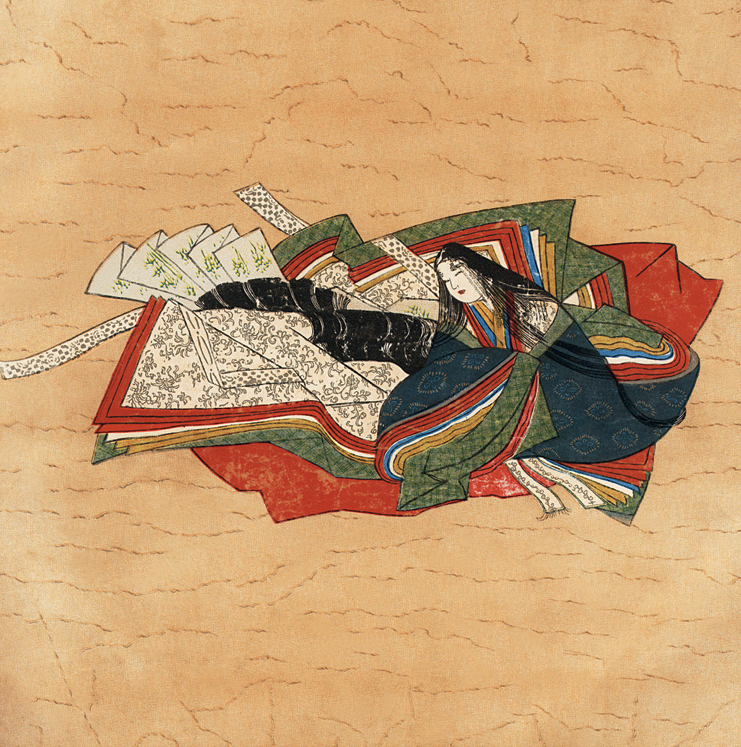A History of World Societies:
Printed Page 382
Listening to the Past
The Pillow Book of Sei Shonagon
Listening to the Past
The Pillow Book of Sei Shonagon
Beginning in the late tenth century Japan produced a series of great women writers. At the time women were much freer than men to write in vernacular Japanese, giving them a large advantage. Lady Murasaki, author of the novel The Tale of Genji, is the most famous of the women writers of the period, but her contemporary Sei Shonagon is equally noteworthy. Sei Shonagon served as a lady in waiting to Empress Sadako during the last decade of the tenth century (990–
The Pillow Book portrays the lovemaking/marriage system among the aristocracy more or less as it is depicted in The Tale of Genji. Marriages were arranged for family interests, and a man could have more than one wife. Wives and their children commonly stayed in their own homes, where their husbands and fathers would visit them. But once a man had an heir by his wife, there was nothing to prevent him from establishing relations with other women. Some relationships were long-
“It is so stiflingly hot in the Seventh Month that even at night one keeps all the doors and lattices open. At such times it is delightful to wake up when the moon is shining and to look outside. I enjoy it even when there is no moon. But to wake up at dawn and see a pale sliver of a moon in the sky — well, I need hardly say how perfect that is.
I like to see a bright new straw mat that has just been spread out on a well-
It is dawn and a woman is lying in bed after her lover has taken his leave. She is covered up to her head with a light mauve robe that has a lining of dark violet; the colour of both the outside and the lining is fresh and glossy. The woman, who appears to be asleep, wears an unlined orange robe and a dark crimson skirt of stiff silk whose cords hang loosely by her side, as if they have been left untied. Her thick tresses tumble over each other in cascades, and one can imagine how long her hair must be when it falls freely down her back.
Nearby another woman’s lover is making his way home in the misty dawn. He is wearing loose violet trousers, an orange hunting costume, so lightly coloured that one can hardly tell whether it has been dyed or not, a white robe of still silk, and a scarlet robe of glossy, beaten silk. His clothes, which are damp from the mist, hang loosely about him. From the dishevelment of his side locks one can tell how negligently he must have tucked his hair into the black lacquered headdress when he got up. He wants to return and write his next-
As he walks along, he passes a house with an open lattice. He is on his way to report for official duty, but cannot help stopping to lift up the blind and peep into the room. It amuses him to think that a man has probably been spending the night here and has only recently got up to leave, just as happened to himself. Perhaps that man too had felt the charm of the dew.
Looking around the room, he notices near the woman’s pillow an open fan with a magnolia frame and purple paper; and at the foot of her curtain of state he sees some narrow strips of Michinoku paper and also some other paper of a faded colour, either orange-

The woman senses that someone is watching her and, looking up from under her bedclothes, sees a gentleman leaning against the wall by the threshold, a smile on his face. She can tell at once that he is the sort of man with whom she need feel no reserve. All the same, she does not want to enter into any familiar relations with him, and she is annoyed that he should have seen her asleep.
“Well, well, Madam,” says the man, leaning forward so that the upper part of his body comes behind her curtains, “what a long nap you’re having after your morning adieu! You really are a lie-
“You call me that, Sir,” she replied, “only because you’re annoyed at having had to get up before the dew had time to settle.”
Their conversation may be commonplace, yet I find there is something delightful about the scene.
Now the gentleman leans further forward and, using his own fan, tries to get hold of the fan by the woman’s pillow. Fearing his closeness, she moves further back into her curtain enclosure, her heart pounding. The gentleman picks up the magnolia fan and, while examining it, says in a slightly bitter tone, “How standoffish you are!”
But now it is growing light; there is a sound of people’s voices, and it looks as if the sun will soon be up. Only a short while ago this same man was hurrying home to write his next-
While all this is afoot, the woman’s original lover has been busy with his own next-
Finally it becomes unseemly for the gentleman to stay any longer. As he goes, he is amused to think that a similar scene may be taking place in the house he left earlier that morning.”
Source: The Pillow Book of Sei Shonagon, edited and translated by Ivan Morris, pp. 60–
QUESTIONS FOR ANALYSIS
- What sorts of images does Sei Shonagon evoke to convey an impression of a scene?
- What can you learn from this passage about the material culture of Japan in this period?
- Why do you think Sei Shonagon was highly esteemed as a writer?